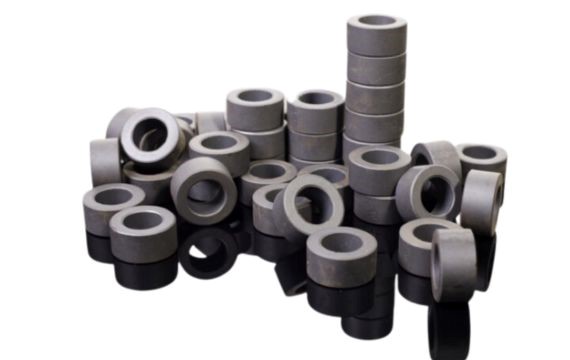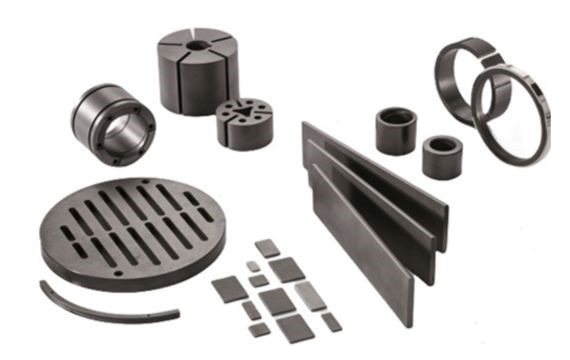If you are looking for a material that blends the superior properties of carbon and graphite, then it’s time to consider carbon graphite.
Carbon graphite is an engineering material with superior properties. It has been modified to manufacture specialty parts or components.
In this guide, we will explore all the fundamental facts about these unique materials. But first, let’s start with:
What is Carbon Graphite?

As the name suggests, this is a special carbon material made from amorphous carbon and graphite. The idea here is to produce material with superior properties.
Besides, you can impregnate carbon graphite with other elements or additives to achieve superior properties. This is critical when you want to customize carbon graphite for specialized applications. You will learn more about this later in this guide.
Having said that, it is important to some basics right:
Comparing Carbon vs Graphite
Well, carbon and graphite are the main components that make carbon-graphite material. At the same time, it is worth noting that graphite is one of the most common allotropes of carbon.
Remember, allotrope refers to the different forms in which elements exist physically. For instance, the most common allotropes of carbon are:
- Graphite and,
- Diamond

But, that aside, let’s narrow down to the key components forming carbon graphite:
| Amorphous Carbon | Graphite |
| · Strong and Hard · Extremely resistant to wear due to turbostratic disorder · Associated with high friction | · Weak and soft · Self-lubricating properties due to the ordered crystal structure |
By combining these two materials, you can make high-performance parts that work well even in the most challenging applications such as tribological situations.
The idea here is to benefit from the unique arrangement of carbon atoms in graphite to achieve a self-lubricating nature. At the same time, you get mechanically strong and hard material due to the presence of amorphous carbon.
Why Choose Carbon Graphite
There are many reasons why you should consider a material with a mixture of carbon and graphite for specialized applications.
- A wide working temperature
- Wear resistance
- Self-lubricating and sliding properties
- Low wettability
- High strength
- Can handle high-load applications
- Chemically stable
- Resistant to most corrosive environments
- Thermally stable material
- Easy to impregnate with other products to achieve specific application requirements.
In short, a mixture of carbon and graphite offers unlimited benefits due to their superior properties.
Carbon-Graphite Manufacturing Process
At the moment, you will find two main types of carbon-graphite materials. The classification criteria are mainly due to the composition of carbon and graphite.
Usually, varying the composition produces material with varying performance criteria. Some of these unique properties include:
- Hardness
- Thermal characteristics
- Strength
Let’s look at the most common variations:
| Various Properties | Composition of Carbon and Graphite (%) | |
| 70% Carbon and 30% Graphite | 30% Carbon and 70% Graphite | |
| Hardness | · 85 | · 65 |
| Thermal properties | · Temperature limit 315 °C · Thermal conductivity 9 W/m.°C
| · Temperature limit 315 °C · Thermal conductivity 12 W/m.°C |
| Strength | · Compressive strength 208 MNm-2 · Flexural strength 62 MNm-2 | · Compressive strength 145 MNm-2 · Flexural strength 52 MNm-2 |
| Modulus of elasticity | · 17 GNm-2 | · 14 GNm-2 |
The formula for carbon graphite composition will determine various properties. With that information, let’s explore how carbon graphite materials are made:
Step 1: Choosing High-Grade Material
Any carbon graphite company will use:
- Materials in powder form – you need graphite and carbon powder. Here, you can choose either natural or synthetic graphite.
- Binder – Coal tar pitch is one of the most common temporary binders during the carbon-graphite manufacturing process. During the production process, the binder holds powder or material structure together.
Step 2: Mixing and Processing Raw Material
Once you have the right proportion of graphite, carbon, and binder, you can proceed to process the mixture.
Depending on the carbon graphite parts you want to make, you can choose:
- ISO molding technique
- Extrusion technique
- Compression molding technique
Remember, whether you choose the molding or extrusion process, the binder will still form part of the final product. As a result, this will lead us to the next step:
Step 3: Sintering or Baking to Remove Binder
At this juncture, the binder will be “holding” carbon and graphite particles together. Remember, the binder will not provide the required strength.
Next, you will bake the molded or extruded carbon and graphite mixture. Usually, this is a critical process, where you must control the entire process carefully.
You should bake the carbon and graphite mixture in an oxygen-free area. The process will carbonize the binder that was holding carbon and graphite particles together.
The result will be a super strong carbon graphite material or part. Even, as you remove the binder there is one thing you will deal with – outgassing.
Step 4: Managing Outgassing
As you bake the carbon graphite material, the process will remove some gases within the material. Usually, we refer to this phenomenon as outgassing. Outgassing produces graphite material with a porous structure.
However, the porous structure of the carbon graphite structure is not bad after all. It makes the final product more functional. That is, you may impregnate carbon graphite with other compounds to achieve unique properties for specialized applications.
Let’s quick overview of the available options:
| Material for impregnation | Recommended Application |
| Thermoset resin | · Coolants · Food and drug industries · Fuels · Oils |
| Antimony | · Light hydrocarbons · Hot water or steam |
| Copper | · High-pressure applications |
| Carbon | · High corrosive uses |
| Fluorides | · Very cold or cryogenic applications · Vacuum |
| Phosphates | · High-temperature applications |
As you can see, every element improves the performance characteristics of carbon-graphite material. Your manufacturer will customize this material depending on your unique application requirements.
Machining Carbon Graphite
Generally, a mixture of amorphous carbon and graphite is easier to machine. Therefore, you can make complex parts and components.
Additionally, machining the material is cost-effective. Remember, the machining process produces excess heat that can cause parts distortion. However, with the self-lubricating property of graphite, friction is highly minimized.
Furthermore, this material can withstand high temperatures besides being thermally stable. Therefore, you can make very complex parts and components. In short, it is for these reasons that a mixture of graphite and carbon is a popular material for most specialized applications.
Types of Carbon Graphite
Broadly, we classify the existing carbon graphite materials as either natural or synthetic. However, you can classify this material further depending on the element you use for impregnation. For instance, you may add fluorides, copper, or carbon.
As the name suggests, we get natural graphite from the mine. On the other hand, synthetic graphite is made through the carbonization process.
Even though we have many types of carbon, amorphous carbon remains the best option.
Applications of Carbon Graphite

As a material designed for specialty parts, a mixture of carbon and graphite is a perfect choice for many applications. Some of the most recommended applications include:
1. Bearing
With the self-lubricating property, carbon graphite works well even in the most demanding applications where traditional lubricants cannot work.
Additionally, with the wide temperature range, these bearings will work in both low temperature (-40 °C) and high temperature (200 °C). Remember, most normal lubricants will be highly viscous at extremely low temperatures or begin to carbonize.
2. Washers and Seals
Carbon graphite can handle high-load applications. Besides, they are chemically inert and thermally stable.
In short, a mixture of carbon and graphite makes the best washers and seals for most industrial applications.
3. Pump Parts and Systems
With its unique performance properties, carbon graphite forms a perfect material for making ball valves seats, and seal rings among other components.
Remember, the superior properties make parts made from carbon and graphite a perfect option for most hydraulic systems. If you want a material that can handle chemicals, fuels, and hot or cold water, then this is the perfect material.
4. Crucible
The thermal stability, withstanding high temperature, and non-stick properties make the material a perfect choice for crucibles.
5. Electrical Components
Graphite structure has free electrons that facilitate electric conductivity. This makes graphite a perfect material for both:
- Static electrical parts such as fixtures, contacts, stationery washers, etc.
- Dynamic electrical components including motor brushes, sliding contacts, etc.
Conclusion
Mixing amorphous carbon and graphite produces a versatile material perfect for a wide range of specialized applications. Besides, you can impregnate the material by adding different elements for better performance.
At KDMFAB, we will help you choose a perfect grade for all your specialized applications – contact us now.
More Resources:
Carbon and Graphite – Source: AZO Materials
Properties of Graphite – Source: EAST CARBON
Natural Graphite vs Synthetic Graphite – Source: EAST CARBON
Properties of Carbon – Source: BYJUS




